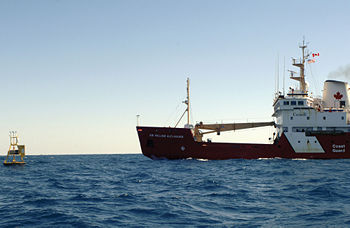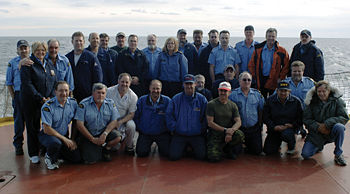CCGS Sir William Alexander: Difference between revisions
Jump to navigation
Jump to search

imported>George Swan (add image) |
imported>Caesar Schinas m (Bot: Update image code) |
||
| Line 1: | Line 1: | ||
{{subpages}} | {{subpages}} | ||
{{Image|Image-CCG Sir William Alexander.jpg|right|350px| CCG Sir William Alexander.}} | |||
{{Image|Crew of the CCG Sir William Alexander.jpg|right|350px| Crew of the CCG Sir William Alexander.}} | |||
'''CCGS ''Sir William Alexander''''' is a [[icebreaker]] in the [[Canadian Coast Guard]], stationed in [[Nova Scotia]]. | '''CCGS ''Sir William Alexander''''' is a [[icebreaker]] in the [[Canadian Coast Guard]], stationed in [[Nova Scotia]]. | ||
Revision as of 06:27, 8 June 2009
CCGS Sir William Alexander is a icebreaker in the Canadian Coast Guard, stationed in Nova Scotia.
The William Alexander left Halifax on September 8, 2005, together with HMCS Athabaskan, HMCS Ville de Quebec and HMCS Toronto, to go to New Orleans to help provide aid following the devastating hurricane Katrina.[1] According to Macleans the William Alexander was not expected to try to keep up with the Naval vessels because, being designed for Arctic waters, she needed to be surrounded by cold water, to cool her engines, if she was to proceed at her top speed [2]
The Sir William Alexander assisted in replacing and servicing navigation buoys.[3]
References
- ↑ Canadian fleet prepares for Katrina relief effort, Globe and Mail, September 8, 2005
- ↑ Deployment of icebreaker to Gulf Coast fuels call for new supply ships, Macleans, September 8, 2005
- ↑ Canadian Beacon-Operation Unison, NOAA, April 2006. Retrieved on 2008-07-13.

